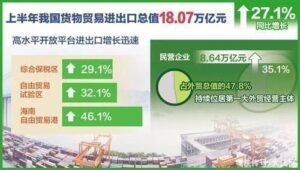
Under the joint action of multiple factors of supply and demand in the global scope, China’s foreign trade witnessed rapid growth in the first half of this year: the import and export of goods worth 18.07 trillion yuan reached the best level in the history of the same period, up 22.8% compared with the same period in 2019. As of June this year, China’s monthly import and export have achieved positive year-on-year growth for 13 consecutive months, and the steady growth of foreign trade has been further consolidated.
As the global epidemic prevention and control gradually becomes normal, the international market demand adjusts, and many manufacturing countries restart production, will there be structural adjustment pressure on China’s export? Can we maintain the rapid growth of foreign trade? Experts in an interview with economic Daily pointed out that despite the change in the gap between international supply and demand in the second half of the year, it is still possible to maintain the good growth trend of foreign trade through targeted policies and measures such as reducing comprehensive costs of foreign trade enterprises.
Supply chains adapt to international changes
Since the outbreak of the global epidemic, China’s comprehensive competitiveness in foreign trade has been further tempered and enhanced through the creative practice of serving and ensuring the production and life of people in other countries. On the one hand, the global economic recovery has boosted international trade and China’s exports. On the other hand, the overall internal driving force of China’s economy continues to strengthen, the main economic indicators continue to improve, and production demand continues to pick up, laying a solid foundation for the steady growth of foreign trade, steady foreign trade policy dividends continue to release, but also create favorable conditions for the development of foreign trade.
“In renminbi terms, China’s imports and exports grew by 27.1 per cent in the January-June period, a record high. This is the result of a combination of supply and demand on a global scale.” Li Xinggan, director of the Ministry of Commerce’s Foreign trade department, said recently that the most critical factor for the rapid growth of foreign trade in the first half of the year was that demand pulled supply.
The epidemic has created a huge gap between supply and demand in the international market. China’s foreign trade supply chain system can quickly adapt to the changing demand in the international market and provide marketable products in a timely manner to meet the needs of countries and regions for epidemic prevention and production. From masks, protective suits, testing kits and vaccines, to serving the home, office and daily needs of people in other countries, Chinese foreign trade enterprises have fully mobilized production resources, improved research and design, strengthened product quality control, and exported a large number of high-quality consumer goods.
In addition to the growth in quantity, the high-quality development of foreign trade in the first half of the year also achieved significant results. For example, high-level open platforms are growing rapidly. In the first half of this year, the growth rate of import and export in China’s comprehensive bonded zones, pilot free trade zones, and hainan free trade port was significantly higher than that of China’s overall foreign trade. At the same time, market entities became more dynamic. There were 479,000 import and export enterprises, up 8.1%. The import and export of private enterprises increased by 35.1%, 8 percentage points higher than the overall growth of foreign trade. In addition, the rapid cultivation of new business forms and models, rapid growth in major trading partners, improved commodity mix, and innovative development of service trade are also prominent features.
Environmental challenges remain
With the acceleration of COVID-19 vaccination, some countries have seen economic recovery and production recovery, which is both a challenge and an opportunity for China’s foreign trade. The challenge is that China’s exports will face the intensification of market competition; The opportunity is that these changes will provide opportunities and impetus for China’s foreign trade industrial chain and supply chain to better adapt to the international market demand and improve its competitiveness.
“In the first half of the year, the strong growth of China’s foreign trade is reflected in high export growth on the one hand and an increase in its share of the world on the other.” Su Qingyi, a researcher with the Institute of World Economics and Politics at the Chinese Academy of Social Sciences, told reporters that as the global economic situation changes, the gap between supply and demand will shrink. Although not as good as the first half of the year, but China’s foreign trade in the second half of the overall situation is still optimistic.
Xu Yingming, a researcher and deputy director of the International Market Research Institute of the Ministry of Commerce, said that the gap between supply and demand in the international market will ease in the second half of the year, but it is still large, and the recovery speed of the supply side is still not as fast as the demand side.
“The rapid growth of foreign trade is due to the transfer of international orders. Due to the disruption of foreign industrial chains due to the epidemic, some international orders have been diverted to China since last year.” Yang Changyong, a researcher at the Institute of International Economics of the Chinese Academy of Macroeconomic Research, said that just because the epidemic situation improves and foreign industrial and supply chains recover, it does not mean that orders will be transferred out again. “Despite the gradual recovery of foreign production capacity, but from the international trade operation rules and multinational companies to prevent the law of risk, there will be no large-scale order transfer phenomenon.”
Recent monitoring by the Foreign Trade Department of the Ministry of Commerce shows that about 40% of foreign trade enterprises have signed a year-on-year increase in new export orders. The recovery of external demand and steady growth of the domestic economy will continue to support the development of China’s foreign trade.
We should strive to solve the problem of “one box is hard to find”
As the base of the same period of last year gradually increased, the growth rate of foreign trade in the second half of the year will decline, and the development of foreign trade is still facing many uncertain and unstable factors. High raw material prices, shipping logistics and other problems further squeeze the profit margins of foreign trade enterprises, but also affect the willingness of enterprises to accept orders. In this regard, Li Xinggan said that China will focus on the outstanding difficulties and problems faced by enterprises in the second half of the year, research and introduce more targeted policies and measures to effectively reduce the comprehensive cost of foreign trade enterprises.
Xu Yingming believes that in the second half of the year, we should do our best to guarantee the supply and stabilize the price of bulk commodities. “On the one hand, we should continue to release the national reserve, and tilt to small and medium-sized enterprises to increase the effective supply and stabilize the price of raw materials. On the other hand, we will closely follow the trend of commodity prices and strengthen the guidance of expectations in the raw materials market.” At the same time, efforts to solve the “hard to find a box” “hard to find a cabin” and other problems. We will support enterprises in increasing container production and actively expand imports. We will encourage maritime enterprises, shipping companies and ports to strengthen cooperation, and guide enterprises to increase the number of temporary vessel operations on major maritime routes. In addition, we will implement policies to support foreign trade market players, especially micro, small and medium-sized enterprises. We will implement taxation and financial support policies for small and medium-sized export enterprises, and support all types of market players, especially small, medium-sized and micro foreign trade enterprises, in maintaining stable production.
In the new stage of development, China’s construction of a new development pattern means it can no longer rely on traditional preferential policies to boost exports, experts said. On the premise of stabilizing employment in the export sector, it is more important to enhance the competitiveness of enterprises and effectively expand domestic demand. We should unswervingly build a new pattern of development and not change our medium – and long-term goals because of the external environment.



